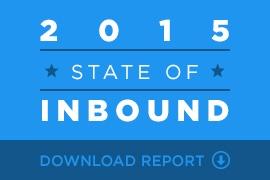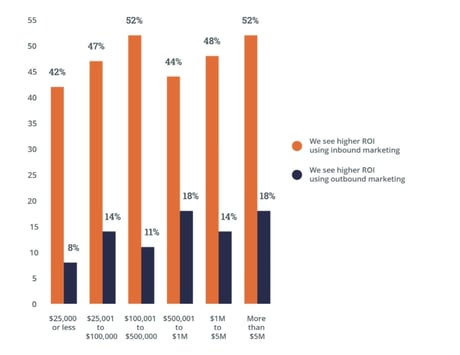Large companies agree on the growing ineffectiveness of outbound, with “approximately 32% of survey respondents whose companies identify as primarily outbound organizations [typically larger companies] call[ing] paid advertising the most overrated marketing tactic” and that they are essentially throwing dollars at big budgets containing traditional media because that’s how it’s always been done.
With the advent of the Internet, business changed. No longer was it the business telling the consumer what they should expect. The consumer’s voice, which is broadcasted instantly to all those who are searching and listening, now dictates by demand. In today's day, the consumers tell the businesses what they want, and if a business, big or small, does not reply to the expectation (demand), the consumer will turn to Google (and yes, sometimes Bing) in search of the next best alternative—which is oftentimes just a single click away.
While the consumer has demand on their side now, the businesses have inherited a buffet of information that can be legally obtained, stored, and extrapolated into insights that lead to informed decisions which become the catalysts that can drive ROI. The beauty for businesses of any size is that this journey of expressed needs becomes data that is mined “which prioritizes compelling content over ads, and pull[s] customers to you rather than push[es] your message onto them.”
Diamonds in the rough anybody? This is Inbound…and everyone wins. Just look at these stats, where businesses of every size see higher ROI when they incorporate Inbound marketing methodologies and solutions.
Other points from the survey to consider include the facts that…
- “Getting more leads and converting more of them is a top priority across company sizes and sectors.”
- “Proving ROI and getting more budget are the leading challenges marketers face.”
- “Companies are worried about increasing leads and conversions, but not the cost of doing so.”
- As well as the fact that “reducing cost of acquiring leads/customers 3x less likely to be prioritized as increasing the number of leads/customers.”
It comes down to getting qualified leads that convert into business. This is the mechanism of Inbound and why companies of all sizes are getting more and more into the methodology.
We are in the final stages of transition from traditional media to an era that lives in the worlds of new media opportunities. Technology is allowing for more, and creatively technical minds are not as limited. While billboards and TV will likely never die, they too evolve. Think of HD Animated Billboards that make the traditional Spectaculars more lackluster. As for TV, that too is now a part of the Internet. Big businesses are big, and it takes time to change. Small business with lesser budgets have discovered new opportunity with the Internet, with global presence a click away. Essentially, small businesses have learned to reach their audience guerrilla warfare style! And it’s paid off, as even big businesses are realizing that nurturing your leads, based on their needs, wins more often that bombarding them with generalized messaging that can get ultimately annoying. Much like the billboards and TV, big business must evolve function to compete in this new world of digital marketing.
Inbound is not only great for driving and leading your qualified users, it allows for internal business evolution as well. Service Level Agreements (SLAs) between marketing and sales teams “who had a formal agreement between Sales and Marketing were more likely to see higher ROI on marketing dollars in 2015, receive a budget increase, and expand their sales teams.” Not only does the methodology nurture leads effectively, it also unifies your internal teams to work together. And every big business can sing their blues of sales versus marketing.
This too is an immediate benefit for the big business to incorporate Inbound methodology and marketing automation solutions into their core operations. The mechanism is the unification of what sales people need to learn about the consumer, who needs what they are selling. For the marketers, the understanding of what the sales teams need to know, allows for them to communicate with the customer in ways that allow them to learn about these specific factors which can then be reported back to the sales team.
The ideas of programmatic and marketing automation go hand in hand. I have to share my affinity for the automation process from my other life as an audio engineer. I remember when I first encountered the idea of automating a fader to allow the harmonic frequencies to dance around what I just did, so I could focus on what I wanted to do next. The same holds true for marketing automation and the Inbound methodology.
It’s the impressions you leave in your consumers mind, with unobtrusive means that allow them to learn and resolve needs related to the very reasons for which they initiated a search via their chosen search engine. Optimize for Google, blanket paid ads and placement across the web, and nurture social networks and native opportunities. Even if all of these media channels work to triple your leads, if you haven’t created a method to market with naturally engaging experiences for your users, then you aren’t leveraging the principles of Inbound. If you leverage Inbound you unify and nurture respondents who will eventually become your customer, driving that elusive ROI. In fact, “every company we surveyed -- regardless of marketing spend -- was three times as likely to see a higher ROI on inbound marketing campaigns than on outbound.”
Big companies, it’s time to listen to the results of the hustle of your smaller competitors. Aligning your markets to needs, based on personas and stages of their decision/buyers journey, allows you to stop throwing wasted dollars at traditional outbound methods. Would you rather throw a big net, just to have to further sort your catch? Or would you rather create funnels that bring the fish to their food with order and ease.
The bounty of modern technology rests in the ability to work smarter and not harder. No matter the size of your organization, nor if you have 3 personas or 33; Inbound methodologies allow you to cut the fluff out of your content creation strategy, and focus on the content for which your customers are searching and by which engaging—you must effectively plan for and track these consumption interactions. “Marketers who were involved with sales software selection were 13% more likely to see a positive ROI, and 11% more likely to receive an increased budget.”
If you answer their questions when they raise their hand, and you are properly tracking your website traffic; you can ultimately turn a randomized (predicted) click into a lead, a name, and then a lifetime value to your bottom line. It comes down to identifying the differences of needs that determine your personas, and then aligning your content, your strategy, and your messaging with what and when they search, click, share, and connect. Inbound is mastering the marketing mix of paid, owned, and earned media channels. Big or small, the benefit and ROI from Inbound cannot be dismissed.



